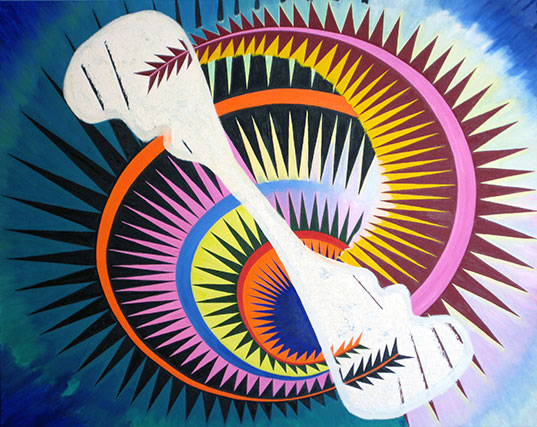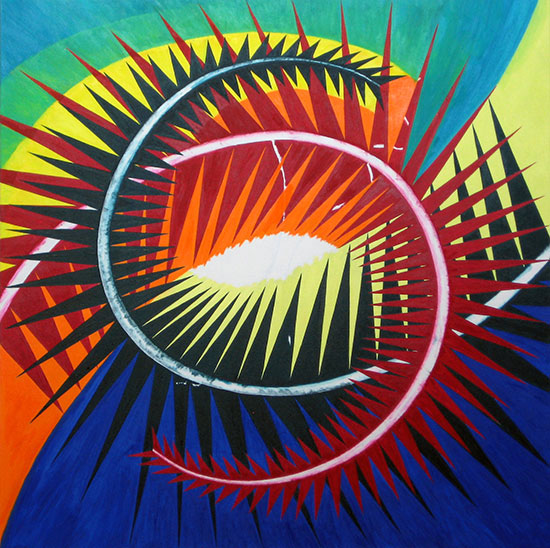The moment I stepped into the little, old structure housing art space 98 at the edge of East Hampton’s main drag of galleries and high-end shops, I sensed a subtext in the work of Thomas Bühler in the “Transformation” exhibition on view.
Big, brassy paintings such as Yin-Yang 1—with its bleached, bone-like form floating over a geometric re-interpretation of the taijitu (“divided circle”)—conveyed an almost tribal sense of decoration gone wild. Blazing hot tones on the upper half and cool blues cut with white on the bottom, the painting renders a jazzed version of the opposition of sun and moon. The decibel level remains raucous all around the room for this small but potent show of 10 works. Yet, even with the titles and the graphic signals of the artist’s trippy palette, I sought a deeper understanding of the message being broadcast.
.

"Yin-Yang I" by Thomas Bühler. Oil on canvas, 48 x 46 inches. Courtesy of art space 98.
.
The gallery attendant dutifully recited some of the information provided by the artist, who co-founded art space 98 (the name refers to the address, 98 Newtown Lane), with an inaugural exhibition in May 2016. Something was mentioned about painting and language (not painting as language, but painting as a prelude to speech) and that was my next hint that this was not just another re-casting of Taoist symbolism, a theme and variations on one of the most recognizable signs from Asian culture.
“I’m trying to express some kind of primordial communication that is pre-language,” Bühler stated in a press release. From the same “Yin Yang” series, and also using the motif of the white form suspended over a chambered nautilus-type spiral of yellows, oranges, pinks and reds, Unfolding I is the most stately of the abstract paintings in the room. While I had some reservations about the technique in some of the other paintings—clean edges sacrificed to expressive urgency—the hazy clouds of blue in the bottom part of the painting and the jagged border of the curvilinear forms worked well in this vertical format.
.

"Unfolding I" by Thomas Bühler. Oil on canvas, 60 x 48 inches. Courtesy of art space 98.
.
The paintings themselves rely heavily on pattern, especially the backgammon-board style sharply pointed bars that radiate from the curves like stylized sunrays. They also follow certain systematic habits that were enjoyable to follow and interpret. Like the yin-yang idea itself, Bühler works with the dialectical oppositions of light and dark, curved and straight, complementary colors on the chart (blue vs. yellow is a major one) and a resilient division of the top and bottom half of each painting into two visual, and emotional, states. That is what maintains the tension in Double Face 1, a curvier version in which the colors soften and blend behind a doubled iteration of the white bone form. The features of this form are more like a face, in the same way that Picasso used to wriggle his own silhouette into the otherwise abstract shadows of his paintings, often at the edge.
Among Modernists whose work seemed to linger in the margin of Bühler’s style, I thought of Miro and his biomorphic forms, especially the way they would both float and intersect with one another, often segmented by color. Bühler’s habit of bringing almost the whole spectrum into every piece, and flooding them with sunny light, also reminded me of Robert Delaunay, especially the great tondo of the Sun and Moon in the Museum of Modern Art.
Just as Delaunay would unleash the vibrancy of reds and blues while holding them in balance across the picture plane, Bühler’s diagonal pairings of complementary tones make chromatic sense even when the high volume of the colors, their sheer volume, threatens to blow the sense of order away. The vibrant, even agitated play of color and form also unleashes some of the excitement one feels before Edvard Munch or the landscapes of Arnold Schoenberg, the composer and dear friend of Wassily Kandinsky who often took up the paintbrush to soothe his nerves.
That hint about language beyond words was lurking in the primitive air of the forms and the way they interrupted one another. I needed another clue to crack the code, and as so often happens, the artist’s biography provided the solution.
Thomas Bühler lives and works in New York and in Montauk. He studied at the Art Students League, but his CV boasts a few twists as vigorous as the whiplash curves in his work. He also learned to paint with Francis Bott, a master of abstraction, in Paris, as well as at the Instituto Allende in San Miguel in Mexico. Many of his aesthetic ideas (as well as his colors, I suspect) come from pastel drawings he makes while traveling in the Sonoran desert and the arid cactus flats of Baja California Sur. Sand mixed with oil paint lends textural variety to paintings that look flat in reproduction, and the visionary drama of desert epiphanies illuminates many of the works.
I became more intrigued once I learned that the Swiss-born Bühler is an “expressive therapist” who trained at the University of Zurich and moved to New York three decades ago. Incorporating not just painting but other arts—including poetry, dance and theater—the process of making art becomes therapeutic, a part of his gestalt practice. The pieces of the puzzle fit better as I considered the unfettered palette of Astral-1 in the context of the writings of C.G. Jung, for example, on color, feelings and symbolism. Jung would urge his patients—who painted mandalas as part of their therapy—to be unafraid of bright tones. Bühler is one of the most intrepid colorists around, a real Jungian when it comes to the palette.
Jung expected to find yellow, red, green and blue in every mandala, part of a correlation between not just painting and emotion, but between consciousness and alchemy. Those four colors, in some kind of balance, were the visual way to square the circle. Jung was working at a moment when science was sorting the duality of light sometimes behaving like a wave and at other times as a particle.
.

"Unfolding III" by Thomas Bühler. Oil on canvas, 48 x 48 inches. Courtesy of art space 98.
.
Some of the same alchemy that so bewitched Jung (who also painted) is at work in Bühler’s vigorous color choices and shapes. Astrophysics as well as biology are logical sources for the iconography of the works, and the artist has a sure grasp of the meanings as well as visual appeal of Native American imagery. The artist’s zig-zagging force fields and glowing auras invoke organisms evolving through cell division and planets in orbit, the action in a cave painting or tribal weaving.
Like the Jungian binary and quadratic codes, the tendency of Bühler to divide and then subdivide his large canvases into contrasting geometric and chromatic regions offers the key to understanding his composition. The Ovidean narrative of “Transformation” that he is telling is an epic that gradually takes hold the way a story by the leaping flames of a bonfire will warm the inner aboriginal in all of us.
_____________________________________
BASIC FACTS: “Transformation: Recent Oil Paintings by Thomas Bühler” is on view August 26 to September 26, 2016 at art space 98, 98 Newtown Lane, East Hampton, NY 11937. www.artspace98.com
_____________________________________
Copyright 2016 Hamptons Art Hub LLC. All rights reserved.
